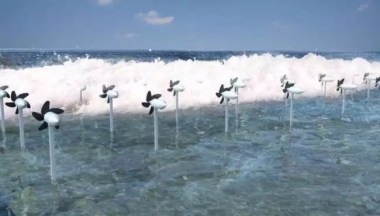Opinion:
¶ “Wind, other renewable energy sources are the answer to climate change” • America’s wind energy industry feels the pain inflicted by Hurricane Harvey. Wind companies have pledged $1 million to Habitat for Humanity to help Texas communities recover from the disaster. But wind power helps in other ways that are important. [Houston Chronicle]
¶ “They Voted For Trump. Obama’s Solar Panels Saved Them From Irma’s Wrath.” • Hurricane Irma knocked out the power while residents Titusville, Florida, sheltered in the Apollo Elementary School. But Classroom 408 had electricity, thanks to an economic stimulus program set in motion by President Barack Obama. [Daily Beast]
Science and Technology:
¶ The world’s periglacial zones, home to nearly all of the world’s permafrost, will “almost completely disappear” by the year 2100 even in the most optimistic of scenarios about greenhouse gas emissions reductions, a study says. As all that permafrost melts, vast quantities of methane and carbon dioxide will be released. [CleanTechnica]

Drunken forest, as underlying permafrost melts
(Jon Ranson, NASA Science blog, Wikimedia Commons)
World:
¶ More than 800 biomass projects have won approval of the Japanese government, offering 12.4 GW of capacity. This is equal to about 12 nuclear power stations. The sheer number of projects has raised questions about how they will all find sufficient fuel, and some experts question the environmental value of such large-scale plants. [Japan Today]
¶ Tapping solar energy, Bangladesh has been able to provide access to electricity to over 12% of her population outside the grid network. Over 4.5 million solar home systems have been installed. But with net metering, all of the on-grid users could install solar PVs on their rooftops to provide electricity to the power grid. [The Daily Star]
¶ With a national energy system that chiefly runs on fossil fuels, Iran finally looks set to unlock some of its tremendous potential in clean energy through foreign investment. However, one official believes that domestic bottlenecks could slow down the country’s push for green energy. He says renewables need to be prioritized. [Financial Tribune]
¶ Japanese researchers are looking into a new technology to turn the power of ocean waves into energy and the energy. The blades of turbines are made of a soft material and rotate when the waves hit them. The initial phase of the project has proven successful and researchers are now preparing to install turbines for the first commercial experiment. [I4U News]
¶ India is third in the world in the number of nuclear reactors being installed, at six, while China is leading at 20, the World Nuclear Industry Status Report 2017 shows. The number of nuclear reactor units under construction is, however, declining globally for the fourth year in a row, from 68 reactors at the end of 2013 to 53 by mid-2017. [The Hindu]
¶ The Japanese government plans to submit a law to the ordinary session of the 2018 Diet, in an effort to facilitate offshore power generation by setting out wind turbine installation standards. Japan is an island nation, and some experts estimate that offshore wind turbines can generate five times as much electricity as land-based ones. [Nikkei Asian Review]

Japanese offshore wind power generation facility test (Photo: New
Energy and Industrial Technology Development Organization)
¶ Bahrain is making plans to build a 100-MW solar power plant as part of its renewable energy agenda. The solar plant will be developed in conjunction with the private sector. The plant is expected to be ready to start power production by the end of 2018, according to Bahrain’s minister of electricity and water affairs. [Utilities-ME.com]
US:
¶ Two years ago, 85% of the electricity in Aztec, California, came from fossil fuels. Now, hydropower supplies 37% of its electricity and 6% comes from a solar farm. Last month, officials from Guzman Energy, which sells power to the city, told the City Commission that Aztec could get 40% of its power from wind in the near future. [Farmington Daily Times]
¶ The US solar industry installed 2,387 MW of solar facilities for the quarter, a record increase of 8% over the year-earlier quarter, according to the Solar Energy Industries Association. Mississippi ranked ninth in the country in solar power growth in the second quarter by adding 92.9 MW, thanks largely to utility projects. [Northeast Mississippi Daily Journal]
¶ Southern California Edison is collaborating with Tesla at a battery storage facility in Ontario, California. The batteries can store enough energy to power 15,000 homes for four hours. SCE provides electricity to over 14 million people in a 50,000 square mile area across California, and sees potential for batteries to support renewable power. [CNBC]

California wind farm (Carol M. Highsmith, Wikimedia Commons)
¶ The clean energy revolution continues and solar is leading the charge. In a recently published report, the US DOE’s National Renewable Energy Laboratories has documented that the cost of utility-scale solar, generated from large plants has decreased by 30% within the past year. Utility-scale solar power is a potential game-changer. [Gears Of Biz]
¶ Bills in the Ohio legislature that would subsidize the state’s two nuclear power plants have stalled, but similar energy credits approved in Illinois and New York have won their first round of legal battles. FirstEnergy has been lobbying for a Zero Emission Nuclear Resource Program or “ZEN” for its nuclear power plants. [News-Herald.com]




